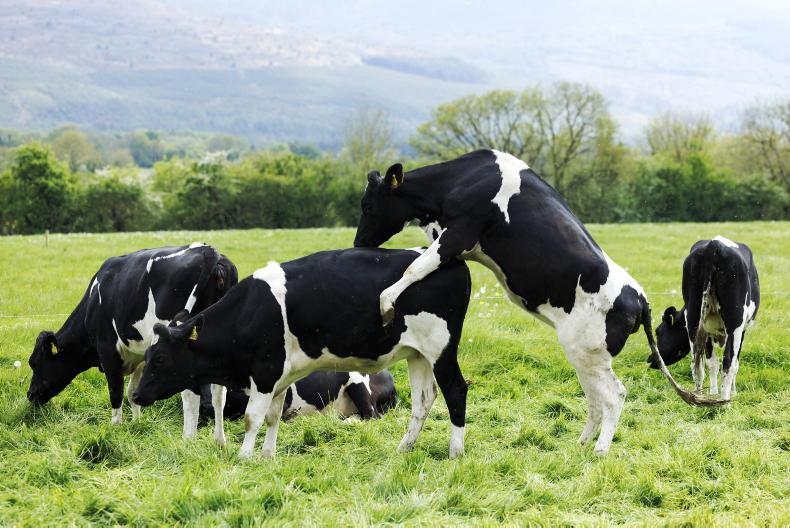Heifer replacements represent a significant investment on the dairy farm.
CAFRE benchmarking shows that the average cost of rearing a heifer is around £1,900 (€2,235) per animal, although there is a wide range in performance, and the top 25% of producers have costs closer to £1,300 (€1,529) per animal.
To maximise the return on investment, Dairylink farmers, along with CAFRE advisers Michael Garvey, Jane Sayers and Judith McCord, have reviewed heifer rearing systems.
The aim is to identify key practices that will help keep costs down and ultimately add to the environmental sustainability of the business.
Setting targets
Research programmes have shown that costs can be minimised by rearing animals to calve down at 24 months old at a pre-calving weight approaching 600kg.
To achieve that, it is important to set and to reach specific weight targets during the rearing phase (Table 1).
Setting targets has allowed project farmers to compare their performance and identify areas for development. While the farms have weighing scales to record heifer weights, they have also demonstrated that a weigh band is a useful alternative if scales are not easily accessed.
A summary of how heifer replacements performed on the farm of Owen and James Martin is also shown in Table 1.
It can be seen that heifers on the farm are currently meeting targets, in particular those approaching first service. This achievement has been mirrored by the other project farmers.
Measuring to manage
Weighing heifers not only highlights the animals on target, it also allows farmers to identify poorly performing animals and take action.
For example, when Stephen Wallace weighed his heifer calves in May 2020, he noticed that around 20% of the animals had a daily liveweight gain (LWG) of less than 0.60kg/ day, which was below the target of 0.75-0.80kg/ day.
Had those animals maintained that level of performance throughout the grazing season, they would have been up to 40kg lighter than their counterparts at housing, delaying the date of first service and subsequent entry into the herd, adding to the overall cost.
However, Stephen was able to separate those animals and feed extra concentrate during the grazing season, allowing them to catch up.
In the case of John Oliver, he noted that calves in the pre-weaning phase in early 2021 were not reaching target weights.
Upon reviewing his feeding programme, he found that the calves were not being offered the planned amount of milk powder. Taking action to correct this allowed his calves to get back on track quickly.
Calf rearing
Getting calves off to the right start is critical to achieving heifer rearing targets, and ultimately, to exploit the genetic potential of each animal. Recent research has highlighted that calves which achieve a daily LWG in the pre-weaning phase of 0.8-0.9kg/day (as opposed to the more traditional 0.5kg/day) are likely to produce more milk and have longer lifespans.
Richard Marshall has devoted time and resources to achieve those targets. This starts from when the cow approaches calving, where he uses alternate calving sheds, allowing him to clean and disinfect one while still using the other. Calves on the farm receive 3-4l of colostrum as soon as possible after birth, with a portable milking machine available to take colostrum from the dam after calving.
Richard has also constructed new calf rearing accommodation in recent years, which ensures calves are maintained in a clean, dry, draught-free environment.
They are initially trained on a bucket and teat system before being moved onto automatic feeders, where individual animals will consume up to 1kg of milk powder daily on a specially formulated product, before being weaned around 70 days old.
A high degree of care and attention to detail is yielding results. Calves that were 30-50 days old were weighed during the 2020/21 calving season and had daily gains between 0.8-0.9kg/ day.
Animal health planning
The final key part of heifer rearing is to complete an animal health plan along with your vet, which covers all aspects of animal health management, including the risk of problems with calves and older heifers.
For example, Frank Goodman has worked closely with his vet to review his vaccination programme, which resulted in Frank adjusting the timing of some of his vaccines. This has led to a better response to vaccines across the herd.
Frank also collected some dung samples from calves during the grazing season and assessed them for worm burdens. Analysing results alongside his vet, Frank altered the timing of his anthelmintics, which enhanced their effectiveness.
Set targets – calve heifers down at two years old approaching 600kg.Weigh replacements regularly. Use data to make effective decisions.Attention to detail is vital. Set up and follow an animal health plan. Read more
Targeted sire selection pays dividends
Multispecies doing the job at Johnstown Castle
Heifer replacements represent a significant investment on the dairy farm.
CAFRE benchmarking shows that the average cost of rearing a heifer is around £1,900 (€2,235) per animal, although there is a wide range in performance, and the top 25% of producers have costs closer to £1,300 (€1,529) per animal.
To maximise the return on investment, Dairylink farmers, along with CAFRE advisers Michael Garvey, Jane Sayers and Judith McCord, have reviewed heifer rearing systems.
The aim is to identify key practices that will help keep costs down and ultimately add to the environmental sustainability of the business.
Setting targets
Research programmes have shown that costs can be minimised by rearing animals to calve down at 24 months old at a pre-calving weight approaching 600kg.
To achieve that, it is important to set and to reach specific weight targets during the rearing phase (Table 1).
Setting targets has allowed project farmers to compare their performance and identify areas for development. While the farms have weighing scales to record heifer weights, they have also demonstrated that a weigh band is a useful alternative if scales are not easily accessed.
A summary of how heifer replacements performed on the farm of Owen and James Martin is also shown in Table 1.
It can be seen that heifers on the farm are currently meeting targets, in particular those approaching first service. This achievement has been mirrored by the other project farmers.
Measuring to manage
Weighing heifers not only highlights the animals on target, it also allows farmers to identify poorly performing animals and take action.
For example, when Stephen Wallace weighed his heifer calves in May 2020, he noticed that around 20% of the animals had a daily liveweight gain (LWG) of less than 0.60kg/ day, which was below the target of 0.75-0.80kg/ day.
Had those animals maintained that level of performance throughout the grazing season, they would have been up to 40kg lighter than their counterparts at housing, delaying the date of first service and subsequent entry into the herd, adding to the overall cost.
However, Stephen was able to separate those animals and feed extra concentrate during the grazing season, allowing them to catch up.
In the case of John Oliver, he noted that calves in the pre-weaning phase in early 2021 were not reaching target weights.
Upon reviewing his feeding programme, he found that the calves were not being offered the planned amount of milk powder. Taking action to correct this allowed his calves to get back on track quickly.
Calf rearing
Getting calves off to the right start is critical to achieving heifer rearing targets, and ultimately, to exploit the genetic potential of each animal. Recent research has highlighted that calves which achieve a daily LWG in the pre-weaning phase of 0.8-0.9kg/day (as opposed to the more traditional 0.5kg/day) are likely to produce more milk and have longer lifespans.
Richard Marshall has devoted time and resources to achieve those targets. This starts from when the cow approaches calving, where he uses alternate calving sheds, allowing him to clean and disinfect one while still using the other. Calves on the farm receive 3-4l of colostrum as soon as possible after birth, with a portable milking machine available to take colostrum from the dam after calving.
Richard has also constructed new calf rearing accommodation in recent years, which ensures calves are maintained in a clean, dry, draught-free environment.
They are initially trained on a bucket and teat system before being moved onto automatic feeders, where individual animals will consume up to 1kg of milk powder daily on a specially formulated product, before being weaned around 70 days old.
A high degree of care and attention to detail is yielding results. Calves that were 30-50 days old were weighed during the 2020/21 calving season and had daily gains between 0.8-0.9kg/ day.
Animal health planning
The final key part of heifer rearing is to complete an animal health plan along with your vet, which covers all aspects of animal health management, including the risk of problems with calves and older heifers.
For example, Frank Goodman has worked closely with his vet to review his vaccination programme, which resulted in Frank adjusting the timing of some of his vaccines. This has led to a better response to vaccines across the herd.
Frank also collected some dung samples from calves during the grazing season and assessed them for worm burdens. Analysing results alongside his vet, Frank altered the timing of his anthelmintics, which enhanced their effectiveness.
Set targets – calve heifers down at two years old approaching 600kg.Weigh replacements regularly. Use data to make effective decisions.Attention to detail is vital. Set up and follow an animal health plan. Read more
Targeted sire selection pays dividends
Multispecies doing the job at Johnstown Castle









SHARING OPTIONS